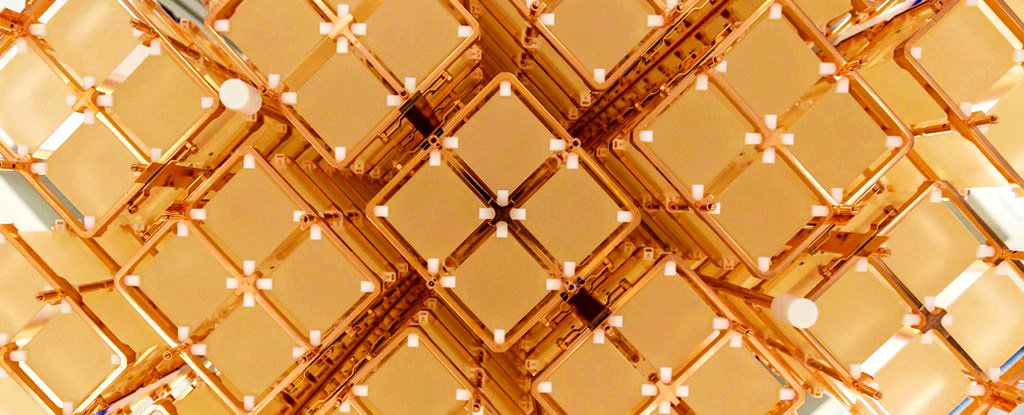Why Does The Universe Exist? — Scientists Are Probing The Biggest Mystery in Physics, And The First Results Are In

Experiments searching for a solution to one of physics' most perplexing mysteries have recently been delivering their first rounds of results, setting new limits on where we need to look for evidence.
Based on our current understanding of physics, matter shouldn't exist. The fact it does means something is off in our equations, and scientists are going to some extreme lengths to determine exactly what it is.
Right now there are four major experiments being conducted around the world, hunting for signs of barely-detectable particles undergoing ridiculously rare changes.
To understand why it's worth the effort, we have to go back to the beginning of everything: as subatomic particles cooled out of the radiation that made up the first blink of the Universe, they took one of two forms – what we now describe as matter and antimatter.
The problem is, these mirror-opposite objects also cancel out in a flash of energy when they meet again. If both types of particles are created next to one another in equal amounts, simple mathematics says we should have nothing left over.
While a pinch of anti-matter is still hanging around 13.8 billion years after that great annihilation, most visible objects are made from just one kind of particle – matter. Clearly the sums are out, most likely somewhere between the creation of the particles and their cancellation.
A type of particle called a neutrino offers a potential answer to this paradox.
As the name suggests, neutrinos are neutrally charged. That, and the fact they're a million times lighter than an electron, means they barely interact with other particles.
But the odd properties of these 'ghost particles' also mean there's a possibility neutrinos are actually matter and anti-matter in one – kind of a mirror form of themselves.
If it can be demonstrated as true, a pathway opens for explaining why our Universe didn't immediately cancel itself out.
One way to find out is to look for the conservation of a particular quantum number as pairs of neutrons decay within certain isotopes. Particles produced by this decay should total up to a balance of lepton numbers: if a +1 comes out, a -1 should appear as well.
In isotopes where a pair of neutrons turn into a pair protons, we can expect two electrons and two neutrinos. Since the neutrinos should have opposite lepton numbers to electrons, we can refer to this variety as antineutrinos.
In the unlikely but exciting case of not seeing those antineutrinos, the lepton number rule would be broken. This would give us some wiggle room to explore how neutrino behaviour just might lead to one kind of matter dominating over the other.
This is all good on paper, but remember, neutrinos don't exactly arrive waving a red flag. Which is where these four experiments come in.
The Cryogenic Underground Observatory for Rare Events (CUORE) at Gran Sasso Laboratory in Italy is based on just a tell-tale flash in one of 1,000 crystals of tellurium dioxide to advertise the moment of a neutrinoless double-beta decay.
For any one molecule of tellurium dioxide, we'd expect this to happen once in a period of 10 septillion years (1 followed by 25 zeroes). Even with the number of molecules in all of those crystals, they expect to see only five decays in the next five years.
"It's a very rare process – if observed, it would be the slowest thing that has ever been measured," CUORE member Lindley Winslow told Jennifer Chu at MIT News.
Incidentally, the whole experiment is kept at a chilly 6 degrees Kelvin above absolute zero, also making it the coldest cubic metre of space in the entire Universe.
A second experiment at Gran Sasso is using isotope germanium-76 instead. They have less material to catch the decay, but the whole set-up is proving to be extremely sensitive, reducing the risk of missing the event if it happens.
Across the Atlantic in New Mexico, the Enriched Xenon Observatory (EXO-200) is housing an experiment 600 metres (1970 feet) underground based on potential decays in the isotope xenon-136.
Also in the US at the Sanford Underground Research Facility, a collaboration are working on an experiment called the MAJORANA Demonstrator. This time it's a lump of germanium-76 tucked under 1.6 kilometres of rock, inside an old mine.
The team recently shared their own analysis of their set-up, and have shown all of that surrounding rock is doing a top job of shielding their detectors from stray bits of radiation that might raise false alarms.
So far, the results from these experiments have reduced places to hunt for this rule-breaking anomaly. That's helpful, but not quite the answer we're looking for.
Then again, it's only the existence of the Universe as we know it that's at stake. So let's keep our fingers crossed they see something weird in the next few years.
The research has been published in Physical Review Letters here, here, here, and here.
Comments
Post a Comment